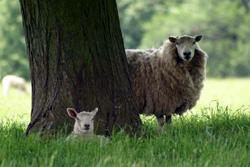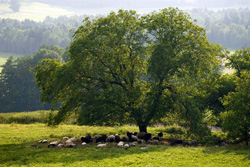Sheep shelter guidelines
Prevention of Cruelty to Animals Act
Sheep are kept in a variety of situations, ranging from extensive grazing to close confinement and housing.
Section 9 of the Prevention of Cruelty to Animals Act 1986 defines cruelty offences and requires that proper and sufficient shelter is provided for animals.
Healthy sheep can tolerate a wide range of temperatures if they are acclimatised and have enough feed and water. Shelter can improve the welfare of the sheep and reduce production losses. Sheep without shelter need to put more energy into normal functioning and less into production.
Sheep should be provided with shelter in times of above or below average temperatures. This can minimise the impact of climatic extremes and prevent suffering or possibly death.
The amount of shelter provided should be sufficient for all animals to access it at the same time, and stocking rates may need to be adjusted to allow for this. This will prevent overcrowding around areas of shade or water.
Shelter in hot weather
While the Merino is considered to be better adapted to hot and shadeless conditions than British breeds, all sheep can experience heat stress to some degree on days of above average heat.
Sheep cool themselves primarily by increasing their respiration rate, and can also lose a small amount of heat through sweating. Heat stress and exhaustion should not occur if sheep are able to find shade and rest during the hottest part of the day.
Heat stress
Periods of extreme heat can cause heat stress, with lambs again more susceptible than adult sheep. Heat stress can:
- reduce productivity
- cause reproductive problems such as reduced semen quality
- lower birth weights
- compromise the immune system
Lambs and pregnant ewes are more at risk of heat stress due to their lower heat threshold and sheep with a history of respiratory disease due to a decreased ability to dissipate heat through panting.
Suitable shelter during hot weather
The best type of shelter during extreme heat protects animals from the sun and allows for the cooling effect of the wind. Some options for shelter in hot weather are:
- constructed shelters using materials such as shade cloth, corrugated iron or timber
- trees with large canopies — planted individually in fields
- naturally undulating paddocks and gullies
- shelterbelts — thick hedges of trees
Shelterbelts can provide good protection from sun, but should be thinned evenly to allow wind flow and planted in an east-west direction to provide shade during the hottest part of the day.
It is important that sufficient shelter is available for all animals at the same time to prevent sheep crowding and smothering. It is preferable that all animals are able to lie down as this helps them cool themselves.
Shelter and water
Water should be close to shelter and be of sufficient volume to cope during periods of peak demand.
Care should be taken when placing shelter near water so it does not result in animals camping around the water source, causing overcrowding and preventing animals from accessing water.
You might need to reduce the stocking rate into several small mobs, as even if sheep have access to several paddocks with shelter, mob instinct means that they tend to group together under one shelter or water source.
Shelter in cold weather
Cold weather, particularly when combined with wet and windy conditions, can have severe impacts on sheep especially lambs and recently shorn animals. It is important that lambing ewes and recently shorn sheep are put into areas or paddocks that contain the best shelter or protection from the elements.
Suitable shelter for extreme cold include:
- constructed wind breaks such as corrugated iron along fences or hay bales placed in the paddock
- natural undulating paddocks and gullies
- sheds (open on one side) erected in paddocks can provide protection from wind
- forestry blocks can be used as emergency shelter for large numbers of stock, and can provide protection during sudden storms.
Sheltering recently shorn sheep
Freshly shorn sheep can be extremely difficult to move in cold weather so always put shorn sheep straight into a protected paddock with plenty of shelter from the cold if shearing in the colder months of the year.
Shorn sheep are at greatest risk of cold stress in the first three days (or nights) after shearing, and remain at some risk for up to two weeks as fleece growth is insignificant over this short period. Extra feed should be provided to sheep for up to four weeks following shearing to meet their increased energy requirements.
Check predicted weather conditions before putting shorn sheep into a paddock after shearing, so that if a cold snap is forecast, you can leave them in sheltered yards or sheds where they are better protected from the weather.
Shearing within a month before lambing encourages ewes to seek shelter — it does have its own risks, especially if a severe storm occurs shortly afterwards. Pre-lambing shearing must only be considered if ewes are in good condition and have free access to good feed and shelter. Heavily pregnant ewes should not be subject to the handling and feed deprivation that shearing involves. The use of hand shears, a cover comb or snow comb is recommended.
Lambing in bad weather
'Bad weather' in this context involves at least two of the three factors of low temperature, wind and rain. When combined these factors can impose a severe chill factor on newborn lambs. Under such circumstances, a lamb that fails to get a drink soon after birth will become progressively less able to do so.
Around 70% of lamb deaths that occur between birth and weaning take place within 48 hours of birth. The majority of these are believed to succumb to the 'mismothering-exposure-starvation' complex. Losses can be particularly high during short spells of bad weather, which may coincide with peak lambing periods in individual flocks during autumn, winter or spring. Wind and rain combined has an additive effect and it has been shown that a wet coat (rain or amniotic fluid) can increase heat loss by 13%, and by 18% with a wet coat and wind.
Studies have shown that in cold, wet and windy weather, lamb losses can be reduced by around 30% if flocks are provided good shelter. Reducing the wind speed at lambing sites is a critical factor contributing to the increased survival of lambs.
Shelter for lambing ewes
Shelter from cold wind — whether provided by topography, trees, other vegetation or artificial structures — can improve the survival of newborn lambs in the event of cold snap conditions occurring within the first two weeks of lambing. Effective shelter protects lambs from wind, rain and conductive heat loss, as well as enabling exposure to the sun.
Shelter should be familiar and well dispersed to encourage use by ewes isolated from the mob at lambing.
Simply ensuring that shelter is available to the lambing flock may not suffice, because well-insulated ewes may not seek shelter. This may be overcome by lambing down in a narrow paddock, well sheltered by a long shelter belt.
Shelterbelts are the best form of shelter against wind, with the 'shelter zone' spanning a distance about 14 times the height of the trees. If wind speed is reduced, cold stress is markedly reduced.
Trees for protection from wind should be planted in a north-south direction to protect from north and south westerly winds. The trees forming a shelterbelt should be spaced evenly and be semi-permeable in order to slow the wind without creating turbulence on the lee side. Under-planting should be incorporated to prevent wind being funnelled through gaps at livestock level.
Tall wheatgrass stands have been shown to reduce twin mortality by 50%. The hedges are one metre wide and run the length of the paddock in a north-south direction, with perennial ryegrass and clover sown in between. These hedges provide good shelter for lambs as the wind speed at the lee of the hedge can be reduced to less than 1% of that in open areas. Grass hedges are most effective when used in addition to existing shelter rather than trying to create shelter in very exposed areas.
Natural shelter — such as native Poa tussocks, old logs, flax, shrubs and grasses — should be retained to provide shelter for lambs regardless of their mothers' sheltering behaviour, and is very likely to increase lamb survival and possibly growth.
Stress and metabolic diseases in extreme weather
Sheep in poor condition (including those coming out of a drought), sick animals or those with previous history of respiratory disease, are especially vulnerable to the extremes of weather. These animals should be housed separately from the main mob to ensure preferential access to shelter and feed and expedited treatment. Moving animals already under stress requires care and planning so it needs to be done well before an extreme weather event, to prevent further aggravation of the animal's condition.
Animals that have been injured in a natural disaster such as fire or flood need protection from the elements as they will be especially sensitive to the extremes of heat or cold.
Stock showing signs of photosensitivity (sunburn) must have access to shade. Preventative measures are available for some types of photosensitivity, including facial eczema. Sunburnt stock will also benefit from veterinary treatment.
Holding yards
When sheep are in holding yards, use should be made of artificial and natural shade to protect them from extremes of wind, heat and cold.
Shelter is important for young animals if they are left in yards for longer than two hours before transport and loading.
Sheep in feedlots during extreme weather
If your sheep are in feedlots, you must be aware of the climatic conditions and the clinical signs in sheep that are associated with temperature stress.
Sheep in feedlots need to have access to shade and shelter during high temperatures, particularly in areas where the duration of high temperature and high humidity with decreased air movement is prolonged.
In these conditions sheep should be constantly monitored for:
- signs of restlessness
- decreased food intake
- congregating/huddling around water troughs
The cessation of rumination will indicate thermal load stress requiring immediate preventative action.
More information
For more information about the welfare of cattle please consult your private vet or local Animal Health staff via our Customer Service Centre on 136 186.
This information should be read in conjunction with the Code of Accepted Farming Practice for the Welfare of Sheep and Shelterbelts for livestock productivity.